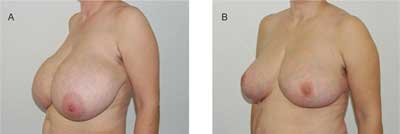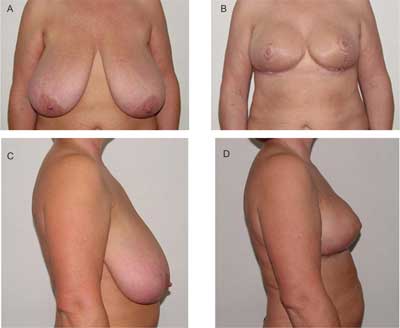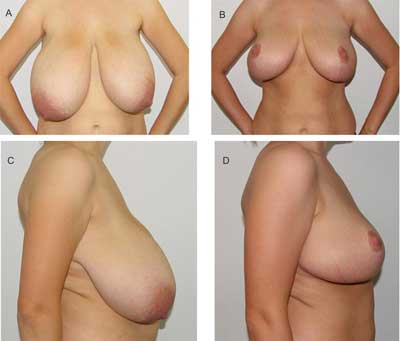© Borgis - Postępy Nauk Medycznych 6/2013, s. 434-440
*Maciej Kulicki, Elżbieta Radzikowska, Zofia Bochen, Józef Jethon
Operacje redukcyjne przerosłych i opadniętych piersi w materiale Kliniki Chirurgii Plastycznej CMKP w Warszawie
Breast reduction surgery of hypertrophic and sagging breasts in the material from the Plastic Surgery Clinic of the Postgraduate Education Centre in Warsaw
Plastic Surgery Clinic of the Postgraduate Education Centre, Warszawa
Head of Clinic: prof. Józef Jethon, MD, PhD
Streszczenie
Wstęp. Przerost i opadnięcie piersi znacznego stopnia jest leczone chirurgicznie ze wskazań medycznych. Powodem zgłaszania się pacjentek do leczenia były schorzenia kręgosłupa, dolegliwości spowodowane uciskiem ramiączek biustonosza oraz odparzenia w fałdach podpiersiowych.
Cel. Celem pracy było zebranie informacji o wskazaniach do redukcji piersi, wynikach leczenia oraz ocena wpływu przerostu piersi na codzienne funkcjonowanie i jakość życia pacjentek.
Materiały i metody. Oceniono grupę 40 pacjentek w wieku od 27-72 lat. Do zebrania danych skonstruowano ankietę porównującą dolegliwości fizyczne oraz aktywność w różnych aspektach życia sprzed i po operacji. Ankietę wypełniło 24 z 40 leczonych pacjentek.
Wyniki. Analiza wyników ankiety wykazała, że wiele pacjentek miało istotne dolegliwości fizyczne jak bóle kręgosłupa, ramion czy głowy. Wpływ leczenia chirurgicznego okazał się znaczący w przypadku bólów kręgosłupa – 96% pacjentek zadeklarowało ustąpienie dolegliwości. Bóle ramion zmniejszyły się wyraźnie u pacjentek, które poprzednio deklarowały duże ich nasilenie, natomiast stosunkowo mniej wyraźnie u pacjentek odczuwających je dopiero pod koniec dnia. Część ankiety dotycząca aspektów psychospołecznych wykazała znaczną aktywizację badanych, poprawę ich samooceny, obniżenie masy ciała (BMI). Większość pacjentek (~90%) jest zadowolona z zabiegu, choć 37,5% spodziewało się lepszego wyniku estetycznego. Wszystkie powtórnie podjęłyby decyzję o poddaniu się operacji.
Wnioski. Redukcja piersi przy zindywidualizowanych kryteriach kwalifikacji przyczynia się do aktywizacji fizycznej i społecznej pacjentek, poprzez zmniejszenie dolegliwości oraz poprawę samooceny. Przerost piersi jest schorzeniem o znaczącym wpływie na funkcjonowanie kobiet w różnym wieku, zarówno w ujęciu zdrowia fizycznego, jak i psychicznego. Obserwowane obniżenie BMI może sugerować potencjalnie pozytywny wpływ na zmniejszenie ryzyka wystąpienia chorób cywilizacyjnych.
Summary
Introduction. Significant breast hypertrophy and ptosis is a medical indication for surgical treatment. Patients seek help because of vertebral diseases, painful bra grooving and inframammary rashes.
Aim. The aim of the study was to evaluate the indications for reduction mammaplasty, treatment results and assessment of macromastia-related quality-of-life.
Material and methods. A total of 40 patients age 27-72 years were included in the study. A special questionnaire for the assessment of health related quality-of-life before and after surgical treatment of macromastia was developed and sent to the patients by post. Of the 40 patients 24 answered the survey.
Results. The majority of patients had substantial health burdens, e.g. back pain, shoulder pain or headache. Reduction mammaplasty provided significant relief of back pain – 96% of patients declared complete elimination of symptom. Severe shoulder pain was significantly alleviated, but the decrease of moderate and mild shoulder pain was less visible. Furthermore the results revealed an increase in physical activity, self confidence and weight loss causing BMI decrease. The majority of patients (~90%) were satisfied with surgical results, although 37.5% of them expected a better aesthetic effect. All patients considered their agreement to undergo surgery a good decision.
Conclusions. Individualized qualification for reduction mammaplasty provide an increase in patients’ physical and social activity, relief of macromastia-related symptoms and improvements in self confidence.
Breast hypertrophy is a disease that influences the lives of women of various ages considered in the context of the physical and mental health burden. The observed decrease of BMI can suggest a potentially positive impact on reducing the risk of diseases of affluence morbidity.

Introduction
Breast reduction surgery is a procedure that allows an achievement of optimal and sustainable results in patients with breast hypertrophy provided that the conditions of appropriate qualification and choosing the surgical technique are met (1-3). In recent years, the scope of indications for surgical treatment of hypertrophic breasts has significantly expanded. Currently, the indications include: spinal disorders associated with the increased load and causing back pain, painful indentations around the clavicules and skin rashes located in the folds under the breasts. Some authors postulate to extend the scope of indications for chronic headaches and occipital neuralgia (4, 5). As patients who require reduction of a small amount of tissue benefit from the surgery, the parameter of weight, which until recently had been considered the main selection criterion, is no longer so important (1). In addition to regression or decrease of the basic problems, which were the immediate causes of the surgery, many patients declare an improvement in self-esteem, self-confidence and increased satisfaction with the intimate life. This has an overall positive impact on the quality of life (6-8). According to the Finnish analysis dealing with the relation between the cost of treatment and social benefits, the outcomes for breast reduction were comparable with other procedures, such as hip replacement (11).
AIM
The aim of the study was to gather information from patients who opted for breast reduction surgery in the Department of Plastic Surgery the Postgraduate Education Centre in Warsaw, draw conclusions to assess outcomes and assess the impact of breast hyperplasia on the daily functioning and quality of life. These data clarify the discomfort that patients reported prior to surgery, determine the reduction or elimination of symptoms, as well as changes in everyday life after breast reduction. Besides the somatic symptoms the analysis includes psychosocial problems of patients who, despite an overall health are often kept on the margins of society because of their hypertrophic and sagging breast. After breast reduction surgery many patients, increased physical activity and has established self-esteem. The conclusions of the work indicate the need for access to breast reduction procedures not only as aesthetic, but also as a treatment on medical, societal benefit.
Material and method
The collected data involved about 40 patients operated in the years 2004-2011 at the Plastic Surgery Clinic of the Postgraduate Education Centre in Warsaw. The following parameters were compared: the patient's age breast hyperplasia, the main cause of surgery, specialty of the doctor who referred to the Plastic Surgery Clinic and a subjective assessment of the outcome. The mean age of patients was 42.7 years (range 27-72 years).
The questionnaire was distributed in this group of patients. It consisted of two parts: 1 – contained questions about ailments and difficulties in the activity before surgery, part 2 – contained similar questions to be asked in the same patients but concerned functioning after breast reduction. The questions related to the assessment of physical ailments and psychosocial aspects. The evaluated physical complaints included the presence and evolution of back pain, pain of the shoulder, headaches as well as the occurrence of skin rash in the folds under the breasts. The assessment of psychosocial aspects compared the physical and sexual activity, self-esteem and difficulties in finding proper clothes before and after the surgery. Additionally, patients were asked about their satisfaction with the results of operation and whether if they could turn the time back, would they decide for breast reduction surgery. The questionnaire was completed and sent back by 24 patients (out of 40). The operating methods varied and included both reductions using the vascular pedicle (upper, lower or using the McKissock’s method – fig. 1 and 2) as well as amputations (using the Thoreck’s method and its modifications); the choice depended on the degree of hypertrophy, breast shape, patient’s age and expectations.

Fig. 1. A patient with mastodynia before (A) and after (B) breast reduction using the McKissock’s method.

Fig. 2. A patient with breast hypertrophy before (A, C) and after (B, D) breast reduction on the lower pedicle.
Most often (in 26 cases) the Thoreck’s breast reduction was applied (fig. 3 and 4). It consisted on mastectomy with transferring the nipple-areola complex as a free graft. Often, also the McKissock’s method was employed (12 operated patients) accompanied by transferring the nipple-areola complex upwards on the upper-lower vertical pedicle. In all cases, the skin was incised using the Wise pattern with the resulting formation of scar in the shape of an inverted T.

Fig. 3. A patient before (A and C) and after (B and D) breast reduction performed using the Thoreck’s method.

Fig. 4. A 35-year-old patient with giant breast hypertrophy. Height: 176 cm. Weight 107 kg.
A and C – before surgery; B and D – after breast reduction using the Thoreck’s method.
Powyżej zamieściliśmy fragment artykułu, do którego możesz uzyskać pełny dostęp.
Mam kod dostępu
- Aby uzyskać płatny dostęp do pełnej treści powyższego artykułu albo wszystkich artykułów (w zależności od wybranej opcji), należy wprowadzić kod.
- Wprowadzając kod, akceptują Państwo treść Regulaminu oraz potwierdzają zapoznanie się z nim.
- Aby kupić kod proszę skorzystać z jednej z poniższych opcji.
Opcja #1
29 zł
Wybieram
- dostęp do tego artykułu
- dostęp na 7 dni
uzyskany kod musi być wprowadzony na stronie artykułu, do którego został wykupiony
Opcja #2
69 zł
Wybieram
- dostęp do tego i pozostałych ponad 7000 artykułów
- dostęp na 30 dni
- najpopularniejsza opcja
Opcja #3
129 zł
Wybieram
- dostęp do tego i pozostałych ponad 7000 artykułów
- dostęp na 90 dni
- oszczędzasz 78 zł
Piśmiennictwo
1. Spector J, Karp N: Reduction Mammaplasty: A Significant Improvement at any size. Plastic and Reconstructive Surgery 2007; 120(4): 845.
2. Saariniemi K, Kuokkanen H, Tukiainen E: The outcome of reduction mammaplasty remains stable at 2-5 years follow-up: A prospective study. Journal of Plastic Reconstructive & Aesthetic Surgery 2011; 64: 1573-1576.
3. Blomqvist I, Eriksson A, Brandberg Y: Reduction mammaplasty provides long-term improvement in health status and quality of life. Plast Recconstr Surg 2000; 106: 991-997.
4. Wagner DS, Alfonso DR: The influence of obesity and the volume of resection on success in reduction mammaplasty: An outcome study. Plast Reconstr Surg 2005; 115: 1034-1038.
5. Ducic I, Iorio M, Al-Attar A: Chronic Headaches/Migraines: Extending indications for breast reduction. Plastic and Reconstructive Surgery 2010; 125: 44.
6. Cerovac S, Ali F, Blizard R et al.: Psychosexual Function in Women Have Undergone Reduction Mammaplasty. Plastic and Reconstructive Surgery 2005; 116: 1306.
7. Saariniemi K, Keranen U, Salminen-Peltola P, Kuokkanen H: Reduction mammaplasty is effective treatment according to two quality of life instruments. A prospective randomized clinical trial. Journal of Plastic Reconstructive & Aesthetic Surgery 2008; 61: 1472-1478.
8. Schnur PL, Schnur DP, Petty PM et al.: Reduction Mammaplasty: An outcome study. Plastic and Reconstructive Surgery 1997; 100: 875.
9. Ramon Y, Sharony Z, Mascona RA et al.: Evaluation and comparsion of aesthetic results and patient satisfaction with bilateral brest reduction using the inferior pedicle and McKissock’s vertical bipedicle dermal flap techniques. Plastic and Reconstructive Surgery 2000; 106: 289.
10. Kerrigan C, Collins D, Striplin D et al.: The health Burden of Breast Hypertrophy. Plastic and Reconstructive Surgery 2001; 108: 1591.
11. Tykka E, Rasannen P, Asko-Seljavaara S et al.: Cost-utility of breast reduction surgery – Aprospective study. Journal of Plastic Reconstructive & Aesthetic Surgery 2010; 63: 87-92.




